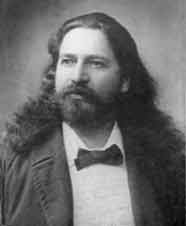
 |
Franz Xaver Reiter
was born in Haag-Oberbayern, Germany on March 19, 1856.
He and his brother, Josef Reiter, were students of Franz
Strauss in Munich. Mr. Reiter's first engagements were
at Sonderhausen and Hanover. In 1882 he participated in
the premier of Parsifal at Bayreuth, playing
first horn together with his brother. In 1886 he was
called again to perform Parsifal at Bayreuth and
also Tristan and Isolde. He was also principal
horn at Carlsruhe.
Boston
In October 1886 he came to the United States to take the
position of principal horn with the Boston Symphony
Orchestra at the invitation of Wilhelm Gericke. Only two
months after his arrival he made his chamber music debut
with Land and Keisel of the Trio for Violin, Horn and
Piano by Brahms, on December 21. 1 He replaced long-time Boston
horn player Edward Schormann.2 During his first season with
the B.S.O. he was featured as a soloist on February 15,
1887 performing "Maieunacht" by Anton Magg. On March 30,
1889 he again appeared as a soloist with the B.S.O.
performing Mozart's Third Horn Concerto. Mr. Reiter also
established himself as a chamber musician, performing on
November 29 and December 5,
1887 "The Faithful Comrade", for voice, piano, and
horn by Storch, and a Sonata for horn and piano by
Kling, with Mr. J. Phippen at the Apollo Club of Boston.
Two days later he played an Adagio by Mozart,
accompanied by Mr. W.A. Locke, for the Boylston Club.
The following season he was heard on December 17, 1888
in a performance of the Beethoven Sextett for strings
and two horns with the Kneisel Quartet and fellow B.S.O.
hornist, J. Schneider. On December 13, 1889 he
participated in the Quintet for Piano, Oboe, Clarinet,
Horn, and Bassoon in E-flat by Mozart in Carl Baermann's
first series at Union Hall.
In a scathing review of what he called a "ridiculous"
performance of Beethoven's, Fifth Symphony by the B.S.O.
on November 9, 1889, Warren Davenport laid blame
squarely on the shoulders of conductor Artur Nikisch for
the uncharacteristic "hoarse blasts" heard from the
horns:
To ask a horn player to force his
instrument until the individuality of its tone is
destroyed and a hoarse blast emitted instead does not
reflect much credit on the taste or judgement of the
conductor who would do such a thing. Mr. Reiter and
his companions have never before been guilty of such
coarse and unseemly sounds as they blasted forth under
the baton of Mr. Nikisch. Mr. Reiter is a wonderful
artist, and produces a large, voluminous tone that can
modulate to the least whisper and expand at his will
to the most gratifying magnitude. It is different in
quality from the tone that we have been accustomed to
in the efforts of the many able performers upon that
noble instrument that have been with us at various
times, Mr. Reiter's tone being more like that which
one gets from the saxhorn type of instrument. I do not
say that it resembles it exactly, but rather not so
much it leans in that direction. This is not so much
because of the heroic element in the player as that he
probably uses the high B horn instead of the F horn.
Mr. Reiter's equal has never appeared in Boston, and
in his greatest moments, under Mr. Gericke's baton, he
displayed a broad and noble conception of his part
that disarmed all criticism. I would impress upon my
readers that never before this mutilation of the Fifth
Symphony under Mr. Nikisch, not even in his most
emotional efforts have I heard Mr. Reiter overblow his
instrument.
Indeed, Mr. Davenport was correct in surmising that Mr.
Reiter preferred the B-horn as did his famous teacher,
Franz Strauss. This was the first season for Mr. Nikisch
as conductor of the BSO. Mr. Reiter had played the
previous three seasons under Wilhelm Gericke to great
acclaim and success, however, two months after the above
performance, in January of 1890, "the
picturesque-looking" Mr. Reiter abruptly left Boston
with no explanation. Perhaps it was due to artistic
differences with Mr. Nikisch, or as several newspaper
reports suggested it was because he was being sued by
his wife, Babette, for separate support (see New
York Times clipping, below). David Mannes relates
yet a third story concerning Mr. Reiter's sudden
departure from Boston:
On his daily walks in and about the city he
was always accompanied by two huge Russian wolfhounds.
While bathing them one morning in the fountain on
Boston Common, he was arrested with his dogs, and all
were confined in jail for a few hours. He was bailed
out only in time to play an afternoon concert of the
orchestra. This indignity to his pride brought Boston
and everything in it his withering contempt. He
deserted the community as one unworthy of his services
as an artist and a free spirit!
Another account stated that he had gone to New York and
would return shortly. But he didn't. Instead, he was
temporarily replaced in the B.S.O. by his brother,
Josef, who had come to the United States leaving his
post with the Bavarian State Opera in Munich to join the
Metropolitan Opera Company in New York. According to the
American Musician the brothers effectively
swapped positions temporarily. At the end of the season
Josef returned to the Met where Xaver was now principal
horn. Xaver also became principal horn of the Brooklyn
Philharmonic under Theodore Thomas. Concerning Xaver's
sudden departure from the B.S.O. and its coming season,
the Philadelphia Inquirer wrote: "He left the
orchestra for private reasons of a domestic kind, and Mr.
Hackebarth, formerly with the Theodore Thomas
Orchestra, will blow the horn in his stead." 3
Baltimore
A few months after leaving Boston, Mr. Reiter was heard
in Brahms' Horn Trio, op. 40 as part of a series for the
Faelten Music School in Baltimore with his former Boston
colleagues, the Kneisel Quartet. This appearance was
probably contracted before his departure from Boston.
The following season (1890-1891) he became principal
horn of the Baltimore Symphony Orchestra which was in
its first season, and was featured as soloist in a
Mozart Horn Concerto. In a retrospective article
published a hundred years later (January 5, 1992), The
Baltimore Sun reported it this way:
The setting was the fussy, gas-lit, old
Academy of Music on North Howard Street. (The Lyric
Theatre was not yet on the scene, but soon would be.)
Xavier Reiter, a horn virtuoso, was on hand to play a
then-rarely-heard horn concerto by Mozart. In the
newspaper article, the anonymous critic says that
Reiter contributed to the piece "cadenzas composed by
himself." The critic found that Reiter "conquered the
difficulties agreeably and with the greatest of ease,"
while perhaps solo horns were not too well adapted for
whole concertos and did better as parts of the
orchestra.
Ladies of the audience drew a breath when the soloist
entered, for he was a tall and "remarkable-looking
man" who had long black hair waving over his shoulders
in the manner of Franz Liszt, Paganini and other idols
of the romantic era.
With only forty-six members, the fledgling Baltimore
orchestra with its season of eight concerts, was no
doubt a step down from the seventy-five-member Boston
Symphony with its season of twenty-four programs at home
and many more on national tour. The Reiter brothers
apparently commuted to Baltimore from New York. In
addition to his commitments in New York and Baltimore,
Xaver Reiter also performed a Mozart concerto with the
Detroit Symphony Orchestra conducted by Rudolf Speil on
April 19, 1892. That event was noted in the Boston
Evening Transcript: "Xaver Reiter, once first horn
of the Boston Symphony Orchestra, has recently made a
success with the Detroit Symphony." In the 1892-1893
season he appeared in several more solo performances in
Baltimore: On December 6, 1892 Mr. Reiter and his
brother, Josef, assisted the Philharmonic Club, a string
quartet and piano in its third season. The program
included the Brahms Trio in E-flat, op. 40. According to
the Baltimore Sun the following day:
Considerable interest was shown in the
first appearance as a vocalist of Xaver Reiter, the
French horn virtuoso. He rendered Mozart's "Air de
Sarastro" and a hunting song with horn obligato, by J.
Reiter, composed for the occasion and dedicated to the
Philharmonic Club. Mr. Reiter has a basso of power and
resonance, and his vocal solos were warmly applauded,
but he is not the artist vocally that he is with the
horn. Beethoven's "Cavatine" and Padre Martini's
"Gavotte" for French horn, with string accompaniment,
played by J. Reiter, formed another interesting
feature of the concert.
The Liederkranz Society's Seventy-fifth Anniversary
Concert and Ball on January 3, 1893 included a solo by
Hans Steiner for soprano (Mrs. Richard Ortmann) with
horn obbligato. Two days later Xaver Reiter was featured
once again as a vocalist on the Baltimore Symphony
concert in the "Quoniam tu Solus Sanctus" from the B
Minor Mass of J.S. Bach, with his brother, Josef,
playing the horn obligato. On the same concert, Xaver
gave the premier performance of the symphonic poem with
horn solo "Mephisto", composed and conducted by his
brother Josef. Josef Reiter also performed the American
premier of the "Symphonic French Horn Concerto" in E
major by Georg Zeller (1857 - ). On February 2nd,
Xaver Reiter was heard in Mozart's Quintet No. 3 in
E-flat, adapted by Baltimore Symphony conductor Ross
Jungnickel for horn and string orchestra. On May 16th,
the concert of the Garland Musical Association included
the "Serenade" for horn and flute (Fred Lax) by Anton
Emil Titl, and another performance of "Mephisto."
|
New York
The following season he left the Baltimore Symphony and
joined the New York Symphony and Damrosch Opera company
under Walter Damrosch, replacing Adolf
Belz. In the summer of 1895 he joined the new
National Symphony Orchestra (New York) under Baltimore
conductor, Ross Jungnickel for a series of promenade
concerts at Madison Square Garden. On July 9, 1896, the
New York Symphony Orchestra was incorporated "for the
cultivation and performance of instrumental music and
the relief of distressed members", with Xavier Reiter as
one of the incorporating directors. In the summer of
1897 Walter Damnrosch and the New York Symphony were
engaged for a series of programs at Willow Grove Park,
Pennsylvania, near Philadelphia. Monday evenings were
"Symphony Nights", Wednesday evenings featured soloists
from the orchestra, including Mr. Reiter, and Fridays
were "Operatic Nights." On September 19 the last day of
that series, Mr. Reiter, billed as the ("World's
Greatest French Horn Soloist"), once again performed
"Mephisto" composed and conducted by his brother Josef.
|
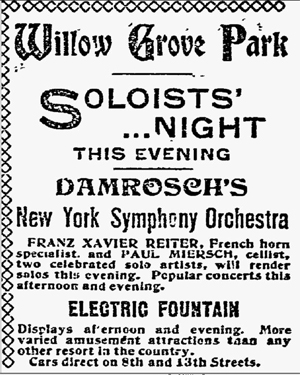
The Philadelphia Inquirer, June 9,
1897 |
Continuing his interest in chamber music, Mr.
Reiter took part in the instrumental music series of the
Brooklyn Institute on November 3, 1897, performing in
the Quintet in E-flat for piano and winds by Mozart, and
the Quintet, op. 16 by Beethoven. The same season, on
April 21, 1898 he was heard at the Haarlem Philharmonic
Society in a performance of composition by Bruno Oscar
Klein's for piano, violin, cello, horn, and voice. Of
his performance in Mozart's Sinfonia Concertante with
Samuel Franko's American Symphony Orchestra on January
15, 1901, O.G. Sonneck wrote "Of the soloists, hornist
Xaver Reiter in particular earned unlimited admiration."
In 1902 Mr. Reiter teamed up with bandmaster John Samuel
Duss as a featured soloist. On June 15, he appeared with
Duss at the St. Nicholas Garden in New York in duets
with harpist, Charles Schuetze, on the same program as
"southern soprano" Edith Helena. Duss gave "his spirited
marches as encores."
In a letter to the editor of The New York Times
(March 8, 1901), concerned citizen, Ambros Chorley, Jr.
made some strongly-worded unfavorable comparisons
between the performance of the New York Philharmonic and
the Boston Symphony Orchestra which he considers far
superior. Although he states that in his opinion
Philharmonic conductor, Emil Paur "has hardly a superior
as a concert conductor ... the Philharmonic Society must
be reorganized." In particular, Mr. Chorley finds the
tone of the Philharmonic's first horn, Mr. Hermann
Dutschke, Sr., generally "woolly" and suggests that he
"give way...to a Xavier Reiter." For the 1902 - 1903
season Mr. Paur was replaced by Walter Damrosch, and it
was announced that he would "lend his first hornist,
Xaver Reiter, to the Philharmonic to strengthen the
brass department in that orchestra." 4
Mr. Reiter next joined the Metropolitan Opera Company,
and his presence was noted by the Washington, D.C. Times
(March 26, 1906) in a review of a performance before
President Roosevelt of Karl Goldmark's The Queen of
Sheba: "One particular feature in the
accompaniment form is the picturesque part assigned to
the French horns. As a matter of fact, in the main solo
work they play an important part, and with Xavier Reiter
in the first chair there is nothing left to be desired."
November 4, 1909, Gustav Mahler made his debut as
conductor of the New York Philharmonic. In a review of
that first performance the next day, The New York
Tribune observed that there had been no diminution
of the Philharmonic forces, but there has been a radical
change in their composition....The brass choir has been
strengthened, and this one feature of last night's
performance which shone with a refulgence which it would
be difficult to find a parallel was Mr. Xaver Reiter's
playing of the horn solo in Liszt's "Mazeppa"; it almost
redeemed that strange combination of a bombastic,
inflated and empty pianoforte etude and a transcribed
Cossack march." Also on the program were Beethoven's
Third Symphony ("Eroica"), and Richard Strauss' "Till
Eulenspiegel" which would be a staple of Mahler's
programming. Mahler was certainly familiar with Mr.
Reiter from previous seasons conducting the Metropolitan
Opera Company. Reiter was one of Mahler's new
appointments to the reorganized "permanent" New York
Philharmonic. In a letter to his wife, Alma, written
from the Netherlands on October 6, 1909, Mahler wrote
"The enclosed letter from Reitler [sic] does in fact
show the man in a different light from that of an
orchestral ignoramus." Mr. Reiter would visit the
Mahlers in their Savoy Hotel apartment to play chamber
music. Mahler had taken an interest in the young
Hungarian pianist, Joseph Weiss, and on one occasion had
invited him to come to the apartment to play the Brahms
Horn Trio with Mr. Reiter and Philharmonic
concertmaster, Theodore Spierling. All went well for the
first movement, but in the second, Weiss became more and
more temperamental, to the point that the others refused
to continue. Weiss stalked out leaving Mahler to play
the piano part himself. Alma Mahler wrote admiringly
that "Brahms's Horn Trio cannot often have been given
such a perfect performance." The Viennese conductor,
Ernst Jokl (1878 - ?) in describing the "frightful lack
of understanding on the part of the orchestra and
public" to Mahler in New York stated: "...the cool
discipline and impersonal matter-of-factness of the
orchestra (with warmth I can record two exceptions; the
splendid concertmaster Spiering and the outstanding
horn-player Reiter, who both really understood Mahler)."
In addition to his duties to Mahler's Philharmonic, Mr.
Reiter once again performed the Brahms Trio on the first
concert of the season of the Marum-Zinsig Ensemble,
December 3, 1910, Ludwig Marum, violin, and Ferdinand
Sinzig, piano. On March 2, 1912 he appeared with the
Kneisel Quartet et. al. in a performance of the
Beethoven Septet, op. 20, in a benefit concert on behalf
of The Musician's Foundation of The Bohemians, the New
York Musicians' Club. Eight years later on December 26,
1920, he would once again appear before The Bohemians
with the same piece.
Under the headline "GREATEST ARTISTS IN WORLD", the Toronto
World announced:
The orchestra which Mr. Nahan Franko has
organized for the Toronto Musical Festival, which
begins at the Arena on Monday, October 7, [1912] will
be one of the finest that have ever been heard in this
country. It consists of sixty-two musicians selected
from the Metropolitan Opera House and the New York
Philharmonic orchestras. Perhaps the most celebrated
man in its personnel is Xavier Reiter, admittedly the
greatest French horn player in the world. His playing
in the Caesar Frank Symphony, when Josef Stransky and
the New York Philharmonic organization presented that
work here last January, is still a glorious memory
among concertgoers.
|
Later that season Mr. Reiter performed a
Mozart Horn Concerto with the Philharmonic, receiving
the following comments from The New York Times:
An unusual feature of the concert last
evening [January 30, 1913] was the performance of one
of Mozart's horn concertos by Xaver Reiter, who plays
French horn for the society. This concerto has not
hitherto appeared on Philharmonic programmes. In fact,
it is doubtful if it has been played before publicly
in this vicinity, if one excepts Reiter's own
performances of it at one of Seidl's Brighton Beach
concerts many years ago.
When played as Mr. Reiter played it, it proved a
delight. The last movement, especially, with its jolly
hunting theme, awoke the audience to great applause.
As for Mr. Reiter's playing one can speak safely in
superlatives, for such horn playing is of the first
order. Not only did he keep perfect intonation, but
his shading, his nuances of tone, were extraordinary.
In the first and last movements he played cadenzas of
great difficulty brilliantly. His trill in the first
cadenza was executed as easily as if he had been a
coloratura soprano.
|
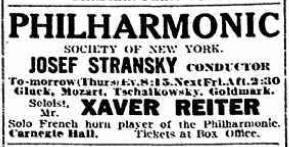
The New York Sun, January 29, 1913
|
A new chamber group, the Philharmonic
Ensemble, was formed for the 1913-14 season, comprising
Henri Leon Leroy, clarinet; Anton Fayer, flute; August
Mesnard, bassoon; Xaver Reiter, horn; Leopold Kramer,
violin; Joseph Kovarik, viola; and Leo Schulz, cello.
Two concerts were scheduled for November 18 and January
27 to be held at Aeolian Hall. Five years later,
referring to the Philharmonic's performance of Brahms'
Third Symphony in 1918, The New York Times said
of Mr. Reiter, his "sonorous golden tone evokes memories
of that horn vaguely heard in the woodland depths by
Alfred De Vigny suffering the claustral seclusion of his
ivory tower."
Bruno Jaenicke joined the Philharmonic as co-principal
horn with Mr. Reiter for the 1921-22 season, and the
next year Mr. Reiter, now 66, moved to third horn. But
he was not ready to settle into retirement on his farm
in Valhalla, New York. In the summer of 1923, Josef
Stransky, recently liberated from his position as
conductor of the Philharmonic, launched a new orchestra,
The State Symphony Orchestra of New York, said to be
organized as a cooperative. It comprised some
eighty-five musicians, many of whom were also
ex-Phiharmonic, including Xaver Reiter. Mr. Stransky
planned a season of fourteen concerts. At the same time
the new orchestra was chosen to accompany the itinerate
Wagnerian Opera Company, replacing the "lamentable"
orchestra of their previous season. The first season
with the Wagnerians was a special treat for Mr. Reiter
as it included Wagner's "Ring" cycle. On December 31,
1924 it was announced that Mr. Stransky would step down
as conductor to spend more time with his art collection.
He was succeeded by Ignatz Waghalter, who continued
through the 1925 - 26 season, which was apparently the
last for the State Symphony. Still not yet ready for
retirement, the now seventy-one-year-old Mr. Reiter was
spotted in a new gig in 1927 by New Yorker music
critic, Robert A. Simon:
There is a new orchestra in town. It is the
property of the astounding Roxy and it functions in
his fascinating new theatre. Although the organization
is only a few weeks old, it has already acquired a
homogeneity and a tone that would be a credit to many
a more venerable ensemble. Mr. Rothafel, in assembling
this orchestra, had no simple task before him, because
he could not emulate the conductor who recently
engaged the Philharmonic personnel and called it
something else. He had to take players whom other
bands had not yet captured, but the performance of the
young orchestra indicated that the others had not
snared all of the good instrumentalists available. We
were startled to hear a horn passage played perfectly
in a cinema theatre. The orchestra moved up and down
on its peripatetic platform so rapidly that it was
difficult to identify the members, but the phenomenon
of the horn passage was explained when we spied the
familiar beard of Xaver Reiter in rapid transit from
the audience level to the recesses of the pit. The two
concertmasters, also, Joseph Stopak and Henry
Nosco, are unusually capable.
The music played in the opening did not test violently
the possibilities of the orchestra. There was a
home-made tone poem depicting the composition of "The
Star Spangled Banner," a few yards of ballet music,
Hosmer's "Southern Rhapsody," with choral
interpolations, a potpourri of airs from "Carmen" and
the score for "The Love of Sunya."
Mr. Reiter continued to perform as a freelancer in New
York through the late twenties, and also was a
consultant in horn design to the H.N.
White musical instrument company of Cleveland.
|
Personal Life and Family
A press release for the New York Philharmonic's national
tour in the spring of 1921 featured a glimpse of Mr.
Reiter's private life:
Xavier Reiter is a soloist of international
repute on his instrument the, French horn. He is also
one of the few orchestral musicians who does not
pursue his profession out of season. Instead he is a
farmer on a large scale at Valhalla, New York, where
he raises not only the usual amount of vegetables and
livestock, but even tobacco and wine (in the days that
are gone).
The newspaper clipping at the right describes the
domestic drama immediately preceding Mr. Reiter's sudden
departure from Boston in January, 1890. He is quoted as
proclaiming "She is a sparrow and I am an eagle." A year
or so later he married his second wife, Josephine Kientz
(b. January 1866, Baden, Germany - Valhalla, NY, June
15, 1950), and together they had the following children:
Magdalena Reiter (1892 - 1990), never
married.
Francesca Reiter (1895 - 1981), never married.
Josephine Reiter (1896 - 1902)
Maria Reiter Rodman (1897 - 1979)
Waldtraut Reiter Greenop Schaft (1900 - 1995)
Friedwalt (Fred) Reiter (1902 - 1988)
Edelmut (Herbert) Reiter (1905 - 1996)
Amelia (Emilia or Emily) Reiter Cheney (1907 - 1984)
|
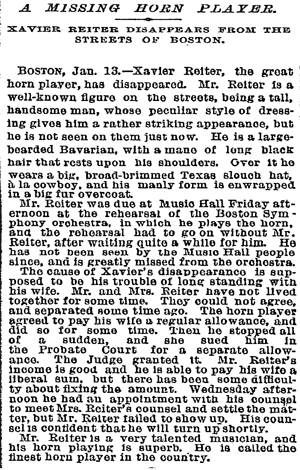
The New York Times, January 14, 1890
|
Franz Xaver Reiter died May 12, 1938 at his
home 16 Oxford Street, Valhalla, New York where he had
lived for thirty-five years. It was noted in his
obituary that in his youth he was a well-known amateur
sharpshooter. It is said that he was responsible for
suggesting the name "Valhalla" in 1904 due to his
association with Wagner's Ring cycle and in
particular his notable performances of the Siegfried
horn call. David Mann relates:
Siegfried and Gotterdammerung
brought Reiter the greatest joy, for was he not the
hunting horn of Siegfried? He refused to sit in the
orchestra but stood in the wings to sound heroically
Siegfried's challenging notes as they had never echoed
before, and as they have never echoed since that time.
Now Reiter lived apart from his colleagues, deigning
to give an occasional nod to us weaklings, for he was
Siegfried the Hero Incarnate. ...
Reiter remained in our orchestra [N.Y. Symphony] until
it was disbanded a few years later; he then joined the
Philharmonic, with which he played up to the time of
his retirement a few years ago to a house he had built
in Westchester County and which he appropriately
enough called Walhalla.... I am told that for years,
in and around the locality of his little house,
Siegfried's horn sounded often through the early
morning hours.
|
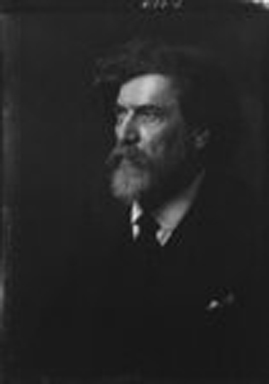 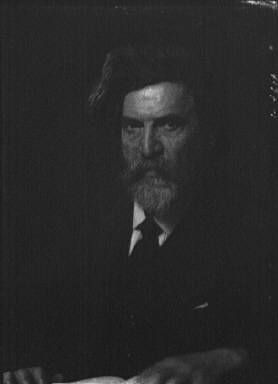
Two portraits of Mr. Xavier Reiter, June 9,
1923, by Arnold Genthe |
|






